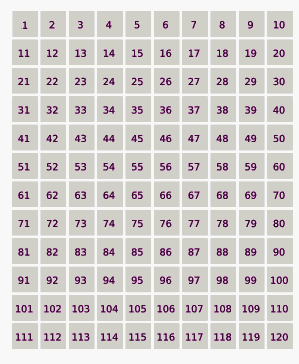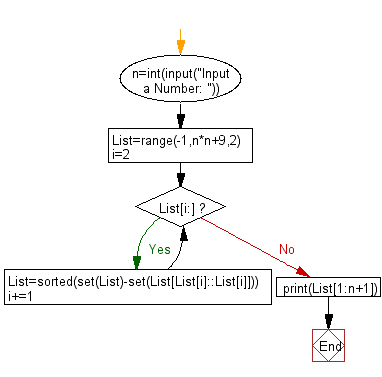Python Math: Print the first n Lucky Numbers
17. Lucky Numbers Generator
Write a Python program to print the first n lucky numbers.
Lucky numbers are defined via a sieve as follows.
Begin with a list of integers starting with 1 :
1, 2, 3, 4, 5, 6, 7, 8, 9, 10, 11, 12, 13, 14, 15, 16, 17, 18, 19, 20, 21, 22, 23, 24, 25, . . . .
Now eliminate every second number :
1, 3, 5, 7, 9, 11, 13, 15, 17, 19, 21, 23, 25, ...
The second remaining number is 3, so remove every 3rd number:
1, 3, 7, 9, 13, 15, 19, 21, 25, ...
The next remaining number is 7, so remove every 7th number:
1, 3, 7, 9, 13, 15, 21, 25, ...
Next, remove every 9th number and so on.
Finally, the resulting sequence is the lucky numbers.
Following animation demonstrating the lucky number sieve. The numbers in red are lucky numbers.

Animation Credits: Celtic Minstrel
Sample Solution:
Python Code:
n=int(input("Input a Number: "))
List=range(-1,n*n+9,2)
i=2
while List[i:]:List=sorted(set(List)-set(List[List[i]::List[i]]));i+=1
print(List[1:n+1])
Sample Output:
Input a Number: 10 [1, 3, 7, 9, 13, 15, 21, 25, 31, 33]
Flowchart:

For more Practice: Solve these Related Problems:
- Write a Python program to generate the first n lucky numbers using a sieve algorithm and print the resulting list.
- Write a Python function that computes lucky numbers from 1 to a given limit and returns the list of lucky numbers.
- Write a Python script to display the first n lucky numbers and then calculate the sum of these lucky numbers.
- Write a Python program to generate lucky numbers and then verify that each number in the list satisfies the sieve criteria.
Go to:
Previous: Write a Python program to print all permutations of a given string (including duplicates).
Next: Write a Python program to computing square roots using the Babylonian method.
Python Code Editor:
Have another way to solve this solution? Contribute your code (and comments) through Disqus.
What is the difficulty level of this exercise?
Test your Programming skills with w3resource's quiz.
